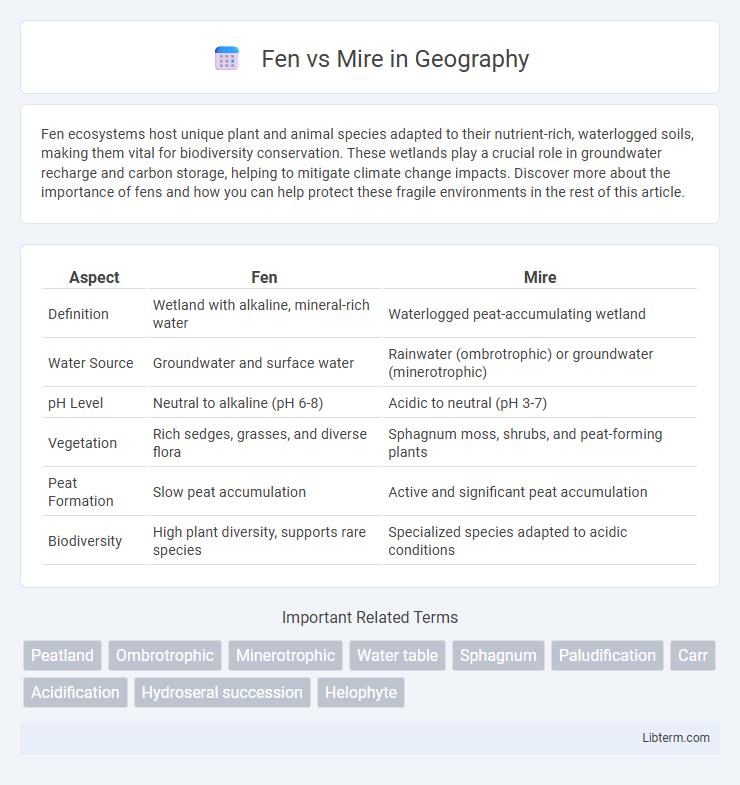Fen ecosystems host unique plant and animal species adapted to their nutrient-rich, waterlogged soils, making them vital for biodiversity conservation. These wetlands play a crucial role in groundwater recharge and carbon storage, helping to mitigate climate change impacts. Discover more about the importance of fens and how you can help protect these fragile environments in the rest of this article.
Table of Comparison
| Aspect | Fen | Mire |
|---|---|---|
| Definition | Wetland with alkaline, mineral-rich water | Waterlogged peat-accumulating wetland |
| Water Source | Groundwater and surface water | Rainwater (ombrotrophic) or groundwater (minerotrophic) |
| pH Level | Neutral to alkaline (pH 6-8) | Acidic to neutral (pH 3-7) |
| Vegetation | Rich sedges, grasses, and diverse flora | Sphagnum moss, shrubs, and peat-forming plants |
| Peat Formation | Slow peat accumulation | Active and significant peat accumulation |
| Biodiversity | High plant diversity, supports rare species | Specialized species adapted to acidic conditions |
Introduction to Fens and Mires
Fens and mires are types of wetlands characterized by water-saturated soils and unique vegetation adapted to anaerobic conditions. Fens are nutrient-rich wetlands fed by mineral-rich surface or groundwater, supporting diverse plant species such as sedges and grasses. Mires, including bogs and fens, are peat-accumulating wetlands where organic material builds up due to slow decomposition in waterlogged conditions.
Defining Fens: Key Characteristics
Fens are peat-forming wetlands characterized by their waterlogged, nutrient-rich, neutral to alkaline conditions, supporting diverse plant communities including sedges, grasses, and wildflowers. Unlike mires, which may be acidic bogs, fens receive mineral-rich surface or groundwater, contributing to higher biodiversity and peat accumulation driven by sedge-dominated vegetation. Key characteristics of fens include persistent saturation, moderate to high pH, and a substrate of partially decomposed organic matter, shaping their unique ecological niches.
Understanding Mires: Types and Features
Mires are wetland ecosystems characterized by the accumulation of organic matter, primarily peat, under anaerobic conditions. There are two main types of mires: fens and bogs, with fens being minerotrophic and receiving nutrients from groundwater, resulting in higher biodiversity and alkaline pH levels. Understanding fen characteristics, such as nutrient-rich water flow and plant diversity including sedges and mosses, helps differentiate them from bogs, which are ombrotrophic and nutrient-poor.
Formation Processes of Fens and Mires
Fens form in mineral-rich, alkaline environments where groundwater or surface water accumulates, fostering peat accumulation through slow decomposition of plant material in waterlogged conditions. Mires develop in areas with poor drainage and consistent saturation, leading to the build-up of acidic peat from partially decomposed organic matter under anaerobic conditions. Both fens and mires play crucial roles in carbon sequestration, but fens maintain higher nutrient levels compared to the more nutrient-poor, acidic mires.
Hydrology Differences: Fens vs. Mires
Fens exhibit higher water tables with flowing, minerotrophic groundwater rich in nutrients, promoting diverse plant species adapted to alkaline conditions. Mires generally have stagnant, ombrotrophic water inputs derived mainly from precipitation, resulting in acidic, nutrient-poor environments dominated by Sphagnum mosses. These hydrological distinctions impact peat formation rates and ecological succession, differentiating fen ecosystems from other mire types like bogs.
Biodiversity in Fens and Mires
Fens and mires are distinct wetland ecosystems with unique biodiversity profiles; fens are characterized by nutrient-rich, alkaline waters supporting a diverse array of sedges, grasses, and specialized orchids. Mires, encompassing bogs and raised bogs, feature acidic, nutrient-poor conditions that favor sphagnum moss dominance and specialized plant species such as ericaceous shrubs and carnivorous plants. Both ecosystems provide crucial habitats for rare invertebrates, amphibians, and bird species, contributing significantly to regional ecological diversity and conservation value.
Ecological Importance and Services
Fens and mires play crucial roles in maintaining biodiversity and regulating water cycles within wetland ecosystems. Fens, characterized by nutrient-rich groundwater inputs, support diverse plant species and act as natural water filters, improving water quality. Mires, often peat-accumulating wetlands such as bogs, serve as significant carbon sinks, storing vast amounts of organic carbon and mitigating climate change effects.
Human Impact and Threats
Fen and mire ecosystems face significant human impact through drainage for agriculture and peat extraction, which disrupts their hydrology and biodiversity. Pollution from agricultural runoff and urban development introduces nutrients and contaminants, accelerating eutrophication and degrading water quality. Habitat fragmentation and climate change further threaten these wetlands by altering water levels and seasonal patterns critical for species survival.
Conservation Strategies
Fen and mire ecosystems require tailored conservation strategies to maintain their unique hydrological conditions and biodiversity. Fen conservation emphasizes groundwater management and nutrient input control to sustain calcareous habitats, while mire conservation focuses on preserving peat accumulation processes through water table regulation and minimizing drainage impacts. Restoration efforts for both prioritize re-establishing natural water flows and protecting native vegetation to enhance carbon sequestration and habitat resilience.
Conclusion: The Future of Fens and Mires
The future of fens and mires depends heavily on effective conservation and restoration efforts that prioritize maintaining their unique hydrological and ecological functions. Climate change poses significant threats, altering water levels and species compositions, which necessitates adaptive management strategies informed by ongoing research. Protecting these peatland ecosystems is essential for carbon sequestration, biodiversity preservation, and sustaining ecosystem services critical for environmental health.
Fen Infographic

 libterm.com
libterm.com